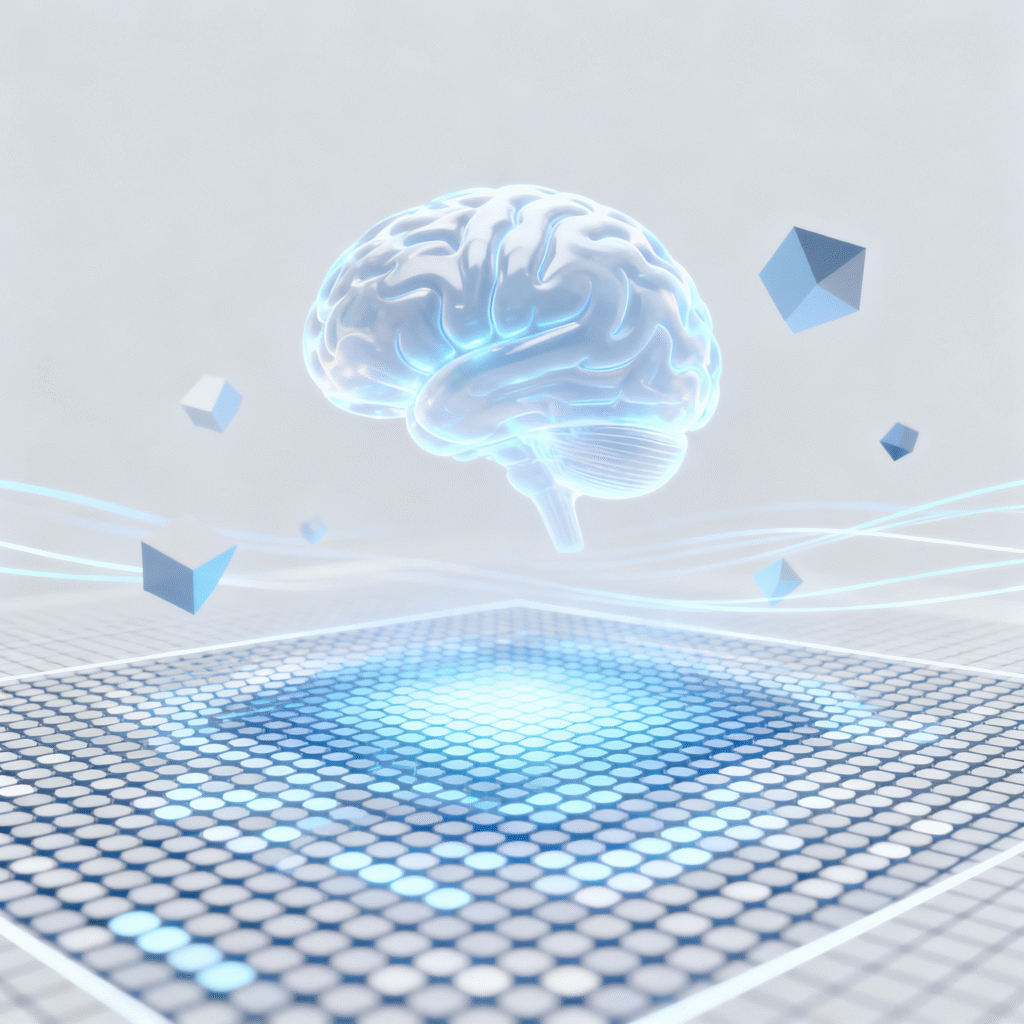
셀룰러 오토마타와 인공지능, 자유 의지, 그리고 한계
본 글은 Perplexity와 나눈 대화를 블로그 글로 정리한 것입니다. 레이 커즈와일의 ‘마침내 특이점이 시작된다’를 읽던 중 나온 ‘셀룰러 오토마타’에 대해 궁금한 것들을 물어보며 나눈 대화 내용을 정리하였습니다.
셀룰러 오토마타란 무엇인가
셀룰러 오토마타(Cellular Automaton)는 격자 형태로 배열된 셀들이 일정한 규칙에 따라 시간의 흐름에 따라 상태를 변화시키는 계산 모델입니다. 각 셀은 보통 0이나 1과 같은 단순한 상태를 가지며, 자기 자신과 이웃 셀들의 상태를 참고하여 다음 단계의 상태가 결정됩니다. 단순한 규칙임에도 불구하고, 그 결과는 매우 복잡하고 때로는 예측하기 어려운 패턴으로 전개됩니다.
역사적 배경
셀룰러 오토마타의 개념은 1940년대에 존 폰 노이만(John von Neumann)과 스타니스와프 울람(Stanisław Ulam)이 자기 복제 기계(self-replicating machine)를 연구하면서 처음 제안되었습니다. 폰 노이만은 초기부터 간단한 규칙으로 복잡한 자기복제 과정을 모사할 수 있음을 보였으며, 이는 생명의 기본 원리를 이해하는 시도의 일환이었습니다.
이후 1970년대와 1980년대에 들어서 스티븐 울프람(Stephen Wolfram)이 셀룰러 오토마타를 체계적으로 연구하고 분류했습니다. 그는 단순한 1차원 이진 오토마타의 규칙들이 보여주는 다양한 패턴을 분석하고, 총 256개의 규칙을 정의하였습니다. 또한 이 중 일부 규칙이 복잡한 계산 능력을 가질 수 있음을 확인하면서 셀룰러 오토마타 연구를 복잡계 과학의 핵심으로 끌어올렸습니다.
규칙 110과 220: 단순성과 복잡성
1차원 이진 셀룰러 오토마타에는 총 256개의 규칙이 존재합니다. 이는 각 셀이 자기 자신과 좌우 이웃을 포함한 총 3개의 셀 상태를 기준으로 다음 단계를 결정하는데, 가능한 조합(총 8가지)에 대해 0 또는 1을 지정할 수 있기 때문에 $$2^8 = 256$$개의 경우의 수가 생기기 때문입니다.
- 규칙 110은 대표적인 복잡계 규칙으로, 무작위와 질서가 공존하는 복잡한 패턴을 생성합니다. 특히 계산 이론에서 중요한데, 규칙 110은 “튜링 완전(Turing complete)”한 오토마타로, 임의의 계산을 수행할 수 있는 잠재력을 가지고 있습니다.
- 규칙 220은 주기적이고 반복적인 형태를 만들어내는 비교적 단순한 규칙입니다. 예측 가능한 패턴이 반복되며, 복잡한 계산 능력은 없지만 규칙성과 안정성을 보여줍니다.
이 두 규칙은 셀룰러 오토마타가 단순성과 복잡성을 동시에 품을 수 있음을 상징적으로 보여줍니다.
인공지능 연구와의 연결
오늘날 인공지능의 주류는 대규모 신경망이지만, 셀룰러 오토마타는 여전히 복잡성 연구와 알고리즘 설계에 중요한 영감을 줍니다. 패턴 인식, 자기 조직화, 분산형 인공지능, 예측 모델 연구 등에서 활용될 수 있으며, 단순 규칙을 통한 복잡성 발현이라는 점에서 인공 생명(alife) 연구와도 밀접한 관련이 있습니다. 또한 신경망 대비 에너지 효율적이고 지역적 규칙 기반이라는 특성 때문에, 차세대 연산 모델로도 주목받고 있습니다.
실생활 속 활용 사례
셀룰러 오토마타는 이론적 모델을 넘어 실제 삶의 여러 영역에서 응용됩니다.
- 교통 흐름 분석: 도로 위 차량의 움직임을 단순 규칙으로 모델링하여 정체 현상을 예측합니다.
- 생물학적 모델링: 세포 분열, 상처 치유 과정, 식물의 성장과 같은 패턴을 모사합니다.
- 도시 및 환경 시뮬레이션: 도시의 인구 이동, 산불 확산, 생태계 변화를 예측하는데 활용됩니다.
커즈와일의 자유 의지 논의와의 연결
레이 커즈와일은 『특이점이 온다』에서 셀룰러 오토마타를 통해 인간의 의식과 자유 의지 역시 단순한 규칙의 복잡한 상호작용에서 비롯된 창발적 현상일 수 있다고 설명합니다. 즉, 인간 정신 또한 근본적으로 계산 가능한 시스템 위에서 발현하는 복잡성이라는 관점입니다. 이는 인공지능 역시 언젠가 인간과 유사한 ‘의식’을 구현할 수 있으며, 기술적 특이점(singularity)이 도래할 수 있다는 주장과 연결됩니다.
셀룰러 오토마타의 한계
그러나 셀룰러 오토마타는 다음과 같은 한계점을 가지고 있습니다.
- 현실성 제한: 현실 세계의 연속적이고 다변수적인 요소를 완전히 반영하기 어렵습니다.
- 초기 조건 민감성: 동일한 규칙이라 하더라도 초기 상태의 작은 변화가 결과 전체를 근본적으로 바꿀 수 있어 예측력이 제한됩니다.
- 적용 범위의 제약: 이산적(discrete) 시스템 모델링에는 적합하지만, 연속적 데이터나 고차원적 환경을 다루는 데는 불리할 수 있습니다.
맺음말
셀룰러 오토마타는 단순한 규칙에서 복잡성과 창발 현상이 어떻게 나타나는지를 설명하는 강력한 도구입니다. 인공지능, 복잡계 과학, 철학적 논의에까지 깊은 영향을 미쳤으며, 여전히 의미 있는 연구 대상으로 남아 있습니다. 다만 모든 복잡성을 단순 규칙으로 환원하여 설명할 수는 없다는 점에서 그 한계 또한 분명히 인식해야 합니다. 그럼에도 불구하고 셀룰러 오토마타는 단순성과 복잡성 사이의 교차점을 탐구하는 데 중요한 역할을 하고 있으며, 앞으로도 다양한 분야에서 탐구될 가치가 충분합니다.
Cellular Automata, Artificial Intelligence, Free Will, and Their Limitations
What Are Cellular Automata?
Cellular Automata are computational models consisting of cells arranged in a grid, whose states evolve over time according to simple rules. Each cell typically holds a basic state such as 0 or 1, and its next state is determined based on its own state as well as those of its neighboring cells. Despite the simplicity of these rules, the resulting patterns can become highly complex and sometimes unpredictable over time.
Historical Background
The concept of cellular automata was first proposed in the 1940s by John von Neumann and Stanisław Ulam during their efforts to study self-replicating machines. Von Neumann demonstrated that complex self-replication processes could be modeled using simple rules, which was part of understanding the fundamental principles of life.
Later, in the 1970s and 1980s, Stephen Wolfram systematically studied and classified cellular automata. He defined a total of 256 rules for one-dimensional binary automata, analyzing the diverse patterns they produce. He also showed that some of these rules possess complex computational abilities, elevating cellular automata research as a core part of complexity science.
Rules 110 and 220: Simplicity and Complexity
There are 256 total rules for one-dimensional binary cellular automata. This arises because each cell’s next state depends on itself and its two neighbors (3 cells total), with 8 possible neighborhood states. Each of these can map to either 0 or 1, resulting in $$2^8 = 256$$ different possible rules.
- Rule 110 is a well-known complex rule that generates patterns exhibiting both randomness and order. Importantly, it is “Turing complete,” meaning it has the capability to perform any computation theoretically possible.
- Rule 220 produces periodic and repetitive patterns and is relatively simple. While it lacks complex computational power, it demonstrates consistency and predictability.
These two rules symbolize how cellular automata can encompass both simplicity and complexity.
Connection to Artificial Intelligence Research
While modern AI is dominated by large-scale neural networks, cellular automata continue to inspire research into complexity and algorithm design. They find applications in pattern recognition, self-organization, distributed AI, and predictive modeling. Their ability to generate complexity from simple rules links them closely to artificial life studies. Moreover, they may serve as energy-efficient, locally governed computational models compared to traditional neural networks.
Practical Applications in Real Life
Cellular automata extend beyond theory into many real-world uses:
- Traffic Flow Analysis: Modeling vehicle movements on roads using simple rules to forecast congestion.
- Biological Modeling: Simulating cell division, wound healing, and plant growth patterns.
- Urban and Environmental Simulations: Predicting population distribution, wildfire spread, and ecosystem dynamics.
Kurzweil’s Discussion of Free Will
In his book The Singularity Is Near, Ray Kurzweil uses cellular automata to illustrate that human consciousness and free will may emerge as complex phenomena arising from simple rule-based interactions. He suggests that human cognition is fundamentally an algorithmic system exhibiting emergent complexity. This view supports the idea that AI may one day emulate human-like consciousness and that a technological singularity could occur.
Limitations of Cellular Automata
However, cellular automata do have notable limitations:
- Limitations in Realism: It is difficult to fully capture the multifaceted and continuous variables of real-world systems with simple discrete rules.
- Sensitivity to Initial Conditions: Small differences in initial states can drastically change outcomes, limiting predictability.
- Scope of Application: They are suitable for discrete systems but less effective for continuous data or high-dimensional environments.
Conclusion
Cellular automata provide a powerful framework for understanding how simple rules can generate complexity and emergent behaviors. They have had profound influence on AI, complexity science, and philosophical inquiries, remaining a valuable area of ongoing research. Although they cannot fully explain all real-world complexity, they continue to offer important insights at the intersection of simplicity and complexity, warranting continued exploration across disciplines.



